Magical History Tour Part 3!
I’ve been waiting to post this blog for over a month! So many other exciting things have been happening but at last I have the chance to post the final part of my wonderful trip to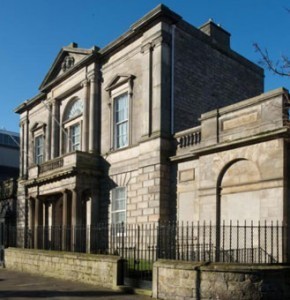 Edinburgh and I’ve saved my favourite bit until last.
Edinburgh and I’ve saved my favourite bit until last.
I love featuring the sea and ships in my books and when I discovered that I could book a special guided tour of Trinity House Maritime Museum I jumped at the chance. We arrived on an exceptionally wet day when we practically had to swim to the door. The museum is housed in an elegant Regency building dating from 1816 (built on the site of a previous medieval almshouse) and it felt full of the history and memories of seafaring. Check out the Trinity House website here if you have an interest in maritime history. It’s wonderful!
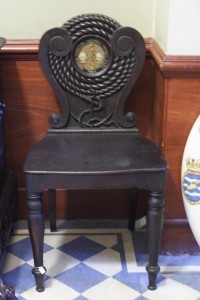 Trinity House describe their historic role as a focus for the seafaring community in the port of Leith and with a brief to look after the welfare of those who went to sea. The building was once the headquarters of the Masters and Mariners and is now a museum packed with treasures of the seafaring past. I had the best time poking around amongst the maps, models and artefacts!
Trinity House describe their historic role as a focus for the seafaring community in the port of Leith and with a brief to look after the welfare of those who went to sea. The building was once the headquarters of the Masters and Mariners and is now a museum packed with treasures of the seafaring past. I had the best time poking around amongst the maps, models and artefacts!
This is mostly a picture blog as I was allowed to wander at will, ask lots of questions and take photos, which was marvellous. I can’t praise Trinity House highly enough as a must see place, a wonderful Regency building with a quirky and fascinating collection and very friendly and well informed guides. The museum and its artefacts and history gave me several story ideas…
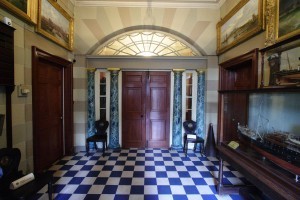 This is the hall. The arms of Trinity House appear on the blue and white floor and also on the chairs (above). A set of six were commissioned from Edinburgh furniture maker William Trotter. They feature wonderful detail of coiled rope and anchors in keeping with Trinity House’s maritime connections.
This is the hall. The arms of Trinity House appear on the blue and white floor and also on the chairs (above). A set of six were commissioned from Edinburgh furniture maker William Trotter. They feature wonderful detail of coiled rope and anchors in keeping with Trinity House’s maritime connections.
The Masters’ Room is still used for meetings of the Masters of Trinity House. It features the wonderful Camperdown fireplace commissioned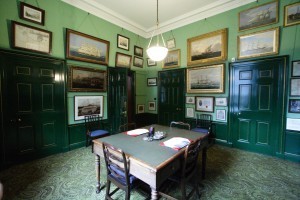 to commemorate Admiral Duncan’s victory at the Battle of Camperdown in 1797. There are four doors opening off the room – some are false, designed to give the room a symmetrical appearance. Leading off this room is the strongroom where the money and important records were stored.
to commemorate Admiral Duncan’s victory at the Battle of Camperdown in 1797. There are four doors opening off the room – some are false, designed to give the room a symmetrical appearance. Leading off this room is the strongroom where the money and important records were stored.
The Convening Room took my breath away in terms of its scale and magnificence. It was intended to be a meeting room for all the members of the Incorporation of Trinity House. A long mahogany table runs down the centre and the room is decorated with beautiful nautical imagery.
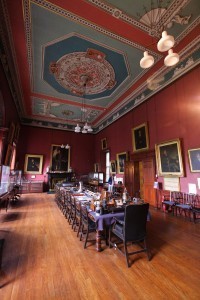 There were so many wonderful artefacts but amongst my favourites was the painting of George IV’s arrival at Leith for the Royal visit to Edinburgh in 1822. The visit had been arranged by Sir Walter Scott and special tickets were issued to spectators. Some of these are on view in the museum. I also loved the 17th century charter chest, the 18th century mahogany ballot box, used by the members for voting, and all the fragile and exquisitely detailed model ships.
There were so many wonderful artefacts but amongst my favourites was the painting of George IV’s arrival at Leith for the Royal visit to Edinburgh in 1822. The visit had been arranged by Sir Walter Scott and special tickets were issued to spectators. Some of these are on view in the museum. I also loved the 17th century charter chest, the 18th century mahogany ballot box, used by the members for voting, and all the fragile and exquisitely detailed model ships.
Over the front door of the museum is a carving with the arms of Trinity House and the words Pervia virtuti Sydera, Terra, Mare: ” The Earth, the sea and the stars are conquerable by men of courage. ” A number of the heroes I have written are adventurers and this seemed the perfect tribute to them. A wonderful place and an inspiration for a writer!
are conquerable by men of courage. ” A number of the heroes I have written are adventurers and this seemed the perfect tribute to them. A wonderful place and an inspiration for a writer!
©2012 Nicola Cornick. All Rights Reserved.
.


